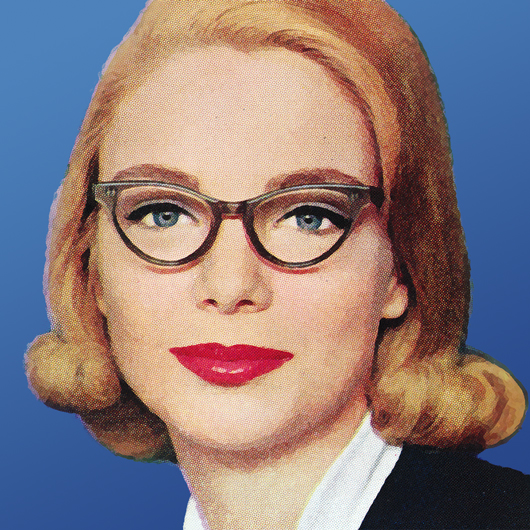
Welcome to Lightning Reviews, where we give you the quick and dirty details on three books. This time, we have two very different nonfiction titles: crafting and history. Plus, a DNF of a young adult fantasy novel.
The Astronaut Wives Club
author: Lily Koppel
The Astronaut Wives Club is an excellent companion to Hidden Figures (nonfiction). While Hidden Figures discusses women who had an active role in NASA’s daily operations, The Astronaut Wives Club tells of the women behind the scenes. The wives of the astronauts formed a tight-knit group that supported each other through photoshoots, their husbands’ absences, terrifying space missions, and deaths.
NASA’s first group of astronauts, The Mercury Seven, was announced in 1959. They were selected in an intensely competitive process and, once selected, had to compete with each other for space flights. NASA believed that having a healthy marriage would contribute to an astronaut’s mental stability and success in space. Their wives were not only under pressure to keep their families functioning while the astronauts were in training, but to keep functioning in a picture-perfect way – always positive, always enthusiastically supportive of their husbands, and always “All American.” Any domestic discord had to be hidden from NASA as well as the press, who were eager to present the wives to the world. No matter how they really felt about missions, the wives always said that they were “Proud, happy, and thrilled,” which became something of an in-joke (and which appears in Apollo 13):
The Astronaut Wives Club does a wonderful job of showing how deliberately the wives grouped around each other to provide and receive support. It also does a great job of showing the personalities and coping skills of the Mercury Seven wives. However, once the focus shifts from The Mercury Seven to subsequent groups, the books gets more scattered (hence the A-). It helps that the front pages include a list of the wives in groups. (“The Original Seven,” “The New Nine,” etc.). The book followed the women from the Mercury Program through the Apollo Missions.
It’s fascinating to see how the women worked together, as well as how the astronaut culture changed between 1959 and 1972, when the Apollo Program ended. Most of the marriages did not survive – there was too much separation, too much infidelity on the part of the astronauts, and too much personal and cultural change for the marriages to last. The epilogue covers a Wives’ Reunion in 1991 at which the women speak openly about stressors they never could have discussed in the past. As Marge Slayton said of the Club, “We were a lifetime membership.”
– Carrie S
Nonfiction
This book is available from:
As an Amazon Associate we earn from qualifying purchases.
We also may use affiliate links in our posts, as well. Thanks!
Kitschy Crafts
author: Jo Packham
Kitschy Crafts: A Celebration of Overlooked 20th Century Crafts is fun on multiple levels. This book is short but full of photos and projects, including instructions. It covers such delights as pin-beaded fruit, latch hook wall hangings, and crocheted toilet paper covers. Why, yes, it does include macrame. It also includes staples like needlework and embroidery, as well as things I never knew existed. Resin grapes? Really?
This book defines “kitsch” as “any decoration that takes itself far too seriously.” Readers will enjoy inward debates about art vs kitsch while making sock monkeys and bottle-cap trivets. The book does not address the fact that most of these crafts were and are primarily made by women. While this book is strictly superficial silly fun, it raises a lot of questions about the definition of kitsch vs. art and the role of gender, class, and time period in determining what has value. If this book offers anything, it’s the idea that value is subjective. For the record, I think doilies are gorgeous but I truly and deeply do not want or need a paint-by-number copy of The Last Supper. I’m good, thanks.

– Carrie S
Crafting, Nonfiction
This book is available from:
As an Amazon Associate we earn from qualifying purchases.
We also may use affiliate links in our posts, as well. Thanks!
Tarot
author: Marissa Kennerson
As someone who reads tarot cards professionally, I was excited about Tarot, a YA novel about a young woman named Anna locked in a Tower in the Land of Pentacles who escapes and flees to the Land of Cups. Alas, this book fails as an allegory, because it casts certain elements of Tarot in a villainous light in a way that is inconsistent with the actual nature of the deck.
It fails even more so as a novel. The characters have no personality and are painted in the broadest of strokes. The plot drags on and on as the denzions of the Land of Cups frolic about. I made it about a third of the way through and gave up. I did peek at the ending, and…
the problems of the characters are suddenly and magically solved by new characters who suddenly appear a few pages prior to the book’s ending to fix everything.
A lot of allegorical works forget that in order to work as allegories, they also have to work as novels (or in whatever medium they are expressed). My problem with this book was the flatness of everything. Anna is Perfect. The King is Very Bad. The people in Cups are Nice. This book needed an infusion of the Witch from Into the Woods, who famously sings, “You’re so nice! You’re not good, you’re not bad, you’re just nice!” Any level of nuance or texture or suspenseful pacing would have helped. This book is not good as a novel and (since I disagree with it’s portrayal of certain characters from tarot) it’s not good as an allegory. I finally had to throw up my hands in despair and move on.
For a Holistic Tarot consultation, you can contact CarrieS at sessarego1@gmail.com!
– Carrie S
Science Fiction/Fantasy, Young Adult
This book is available from:
As an Amazon Associate we earn from qualifying purchases.
We also may use affiliate links in our posts, as well. Thanks!







As someone who rarely pulls cups for myself (as in, so rarely people have checked my deck to make sure I didn’t throw them away) my reaction to flees to the Land of Cups was “Barf, why would anyone want to go there?”
The last book I tried that used cards as a plot device was super literal (she pulled the tower, she went to a tower; she pulled the magician, a magician showed up), which was no better than questionable interpretations. For the sake of my Yer Doin It Rong sensibilities, tarot has been placed on my book avoidance list.
My favourite tarot novel is The Greater Trumps by Charles Williams, written in 1932. It’s definitely of its time (racist, classist) but also rather compelling. The cards, while not alive, are definitely characters with their own agency.
There’s an entire series of romance novels based on the Tarot called “Cards of Love.” The books are all written by different authors and have the same moody, sepia-toned cover art. I’ve read a few and the quality is somewhat uneven—plus, Tarot really doesn’t play much of a role in any of them—but the covers are lovely.
https://www.goodreads.com/list/show/129461.Cards_of_Love
Based on the review of Astronaut Wives Club, I would read the book for the epilogue. If nothing else, to see how women who were required to present as perfect and cheerful at the time, are now real people with strengths and foibles.
As a child of the 60s, I can tell you that we all made kitschy crafts. Macrame was huge (never figured it out personally), but we all had or created it. The wax-covered wine bottle? Oh, yes. Good, weird, times.
@Darlynne: How about “art” using soda can pop tops? I made a belt from pop tops (God knows how much Tab I had to drink) and felt like Marcel Duchamp: the artist says this is art—and so it is!
I own a copy of that Kitschy Crafts book and I unironically love kitsch. Maybe I wouldn’t choose to decorate my home with resin grapes or macramé wall hangings, but I have a large collection of vintage kitchenware (I bought an electric juicer from the 1960’s today). It’s fashionable to poke fun at mid-century cooking and décor, but, to me, serving a meal in my mother’s Corning Ware or using my mother-in-law’s meat tenderizer provides a significant tie to the women who helped make me into the person I am today.
There is a fantastic Paranormal Romance Adventure series by Chandelle LaVaun based on Tarot. The first book in the Elemental Magic series is called the Chosen Witch, and the primary characters are based on the Major Arcana. It is very well done on all fronts. There are a number of quest stories through the series, with characters coming into a wide range of paranormal magical gifts that reflect an aspect of the Major Arcana Card they represent. Charming Fated Mate romances develop and there is lots of adventure and kickass magical action, often led by strong female characters – yea! Really well written and engaging, and it has become one of my favourite Magical Paranormal Series.
@Francesca-I totally agree! I collect Vintage Pyrex, and I love to think of the meals that were served in those beautiful dishes. It is a very real connection to my past (I was born in 1960), and those dishes? They are workhorses!! I love midcentury decor and kitchenware, everything just seemed more colorful and cute. When I found a set of the Pyrex my immediate family used (Early American) it brought back so many happy memories.
There was a very good TV series based on “The Astronaut Wives Club.” Highly recommend it.